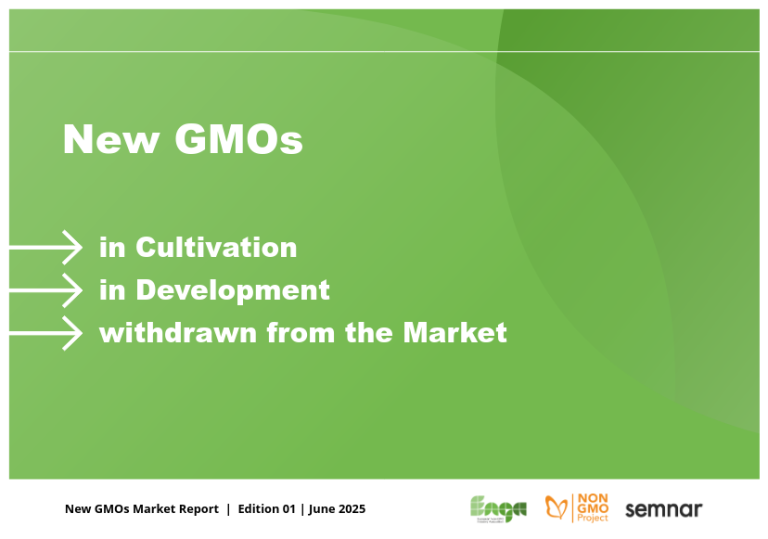News
GMO pigs: sausages for offspring selection

After six years’ work, a research team at Washington State University has succeeded in genetically modifying pigs to turn them into surrogate sires. In other words, carrier fathers. These pigs obtained using the CRISPR/Cas9 molecular system have even been authorised for consumption on an experimental basis, without any prior health assessment. What hidden or overt interests does this innovation really serve?
A research team from Washington State University (WSU) led by Jon Oatley, PhD [1], genetically modified pigs using the CRISPR/Cas9 molecular system. The aim: to delete the NANOS2 gene, which renders these animals male sterile. [2]. They do not produce sperm. But then the researchers transplanted stem cells from donor animals into their testicles to produce spermatozoa. These GMO pigs then began to produce sperm from another pig. In this way, they extended the concept of surrogate mothers to include surrogate fathers [3]. The sperm produced by the surrogate sires contained only the genetic material of the donor animals. The same genetic modification was carried out on mice, goats and cattle. These genetically modified pigs are destined to become surrogate breeders. For Guy Kastler of the Confédération paysanne, “this is a new stage in the refinement of genetic eugenics techniques”. Indeed, in this “selection” scheme, the male is no longer even a sire. He becomes the carrier of millions of fertilising cells that have been “inseminated” into his body from the higher pig.
The scientists claim that CRISPR/Cas9 “is a modern, cutting-edge technology that only works within the DNA of one species” [4]. They therefore argue that “gene editing” (a legally and scientifically unfounded expression) is different from transgenesis. Our readers know that this technique generally requires prior transgenesis. Furthermore, echoing the ideas of those in favour of deregulation of the new GMOs, Jon Oatley states that “gene editing” consists of introducing into a species “changes that could occur naturally or through traditional breeding practices”. However, we are talking here about a series of techniques (including the in vitro culture of isolated cells) for which the probability of occurring in nature is almost nil. The naturalness of these new genetic modification techniques is a lie that many researchers have repeatedly demonstrated.
Preventing the limits of selection and artificial insemination
This work and the recent communication had three aims. The first is to overcome the limitations of domestic animal selection and artificial insemination. Indeed, one of the problems with in vitro fertilisation is that cryopreservation means that the gametes of an ’elite’ bull can be preserved and then used long after his death [5], but it does not work with most other animal breeds (sheep, pigs, etc.). As the same researchers pointed out, “pig sperm does not survive freezing well. In goats, artificial insemination is quite difficult and may require surgery” [6]. This genetic manipulation of pigs combined with the surrogate sire technique overcomes this natural limitation. This combination of techniques makes it easier to disseminate very specific and restricted genetics in the breeding sector. At the same time, this will increase the homogeneity of the animals and industrial property rights.
Humanitarian arguments to the rescue
The researchers’ second aim was to make it clear that the FDA (Food and Drug Administration) is prepared to authorise the marketing of meat from GMO animals in order to “improve food production [which] is a viable strategy to help feed the planet’s growing population” [7]. For Irina Polejaeva, a professor at Utah State University, this technique could help to improve food security in developing countries, where livestock farmers still have to resort to traditional selection (more or less assisted) to improve their livestock. The famous argument of the end of world hunger… “This technology could enable a more rapid spread of the specific characteristics of goats, whether in terms of disease resistance, greater heat tolerance or better meat quality”, she replies to Science Daily [8]. A “humanitarian” endorsement is always welcome…
But why not crossbreed with local breeding stock? At what price will these surrogate breeders or their sperm be sold? Who will sell them? Under what conditions? Since the Neolithic era, mass selection on livestock farms has brought great diversity and resilience to herds, but we have to recognise that the arrival of genetic tools has tended to restrict this diversity. Should we encourage an international market to create adapted breeds, or should we leave farmers to manage their herds as they see fit, within the framework of the local market and with small herds?
Really healthy pigs for consumption?
Thirdly and finally, they also want to prove that “food made from animals is safe” [9]. However, without a label, there is no control batch. And without a control batch, there is no experiment (in the scientific sense). So there can be no conclusion and no assertion. It’s the same story as for GMOs sold in the United States since 1994.
In May 2023, the FDA authorised, on an experimental basis, the consumption of meat from these genetically modified pigs without any prior health assessment and without any requirement to compare the eaters of these sausages with controls [10]. The FDA tells us that “Investigational Food Use Authorizations” (IFUAs) are useful to developers because “they allow animals (or their products) suitable for food to enter the food supply instead of being wasted”. This issue had already been at play with the Recombinetics bulls that the vet wanted to sell as butchery rather than pay to have them butchered.
This request for experimental authorisation and the buzz they organised were clearly aimed at influencing attitudes and institutions. The researchers organised a barbecue with sausages “smoked and lightly salted” whose casings “click well… like normal pork”, they claim. The barbecue was widely reported in the media and on social networks.
After demonstrating the “advantages” of this technique and that the FDA considered it to be safe, the researchers stress the current difficulties in using them, due in particular to overly rigid regulations and the negative public perception of genetic modification.
This is not the first genetically modified animal authorised for marketing and human consumption. The FDA had authorised transgenic salmon [11] and, more recently, in 2020, a transgenic pig, named GalSafe, from the company Revivicor [12]. GM salmon has still not been marketed on a large scale. As for the GalSafe pig, there has been no news of any marketing since it was authorised. But here we are talking about validating a technique designed to speed up a selection process that is moving further and further away from the traditional practice of breeders, to the benefit of sperm sellers and eugenics advocates.
[1] He is also Associate Dean for Research in the College of Veterinary Medicine and Full Professor in the School of Molecular Biosciences. And Mr Oatley is an active member of the Gene Editing in Agriculture Task Force, a collaboration of the American Association of Veterinary Medical Colleges and the Association of Public and Land-grant Universities, set up in June 2020
[2] Sara Zaske, « First university to put gene-edited livestock into human food supply », WSU News, 1er May 2023. This work is the result of a six-year collaboration between researchers at WSU, Utah State University, the University of Maryland and the Roslin Institute (University of Edinburgh, UK).
[3] The expression used by the university is “surrogate sire”, which is the exact translation of surrogate father
[4] Sara Zaske, “First university to put gene-edited livestock into human food supply”, WSU News, 1er May 2023.
[5] Only four bulls are the fathers or grandfathers of all French Prim’Holstein cows born by artificial insemination, i.e. more than 99% of them, explains Guy Kastler
[6] Washington State University, “Gene-edited livestock ’surrogate sires’ successfully made fertile: Advance could transform selective animal breeding”, ScienceDaily, 14 September 2020.
[7] WSU News, Ibid.
[8] ScienceDaily, Ibid
[9] The offspring of these GMOs, surrogate progenitors, have not yet been examined by the FDA for possible inclusion in the food chain. Researchers consider the offspring of these pigs to be “non-GMO”, whereas from a legal and scientific point of view they are indeed genetically modified. But this erroneous assertion means that they do not have to pass through the assessment agencies
[10] This authorisation on an experimental basis has not been published on the FDA website. The FDA issued an IFUA (Investigational Food Use Authorization) and not a NADA (New Animal Drug Application). According to the FDA, “IFUA letters are not published because they generally contain confidential information”
[11] , « États-Unis : le saumon OGM autorisé », Inf’OGM, 4 April 2019.
[12] See:
![]() FDA, “FDA Approves First-of-its-Kind Intentional Genomic Alteration in Line of Domestic Pigs for Both Human Food, Potential Therapeutic Uses”, 14 December 2020;
FDA, “FDA Approves First-of-its-Kind Intentional Genomic Alteration in Line of Domestic Pigs for Both Human Food, Potential Therapeutic Uses”, 14 December 2020;
![]() , « États-Unis : autorisation d’un cochon OGM à la consommation », Inf’OGM, 4 March 2021.
, « États-Unis : autorisation d’un cochon OGM à la consommation », Inf’OGM, 4 March 2021.












